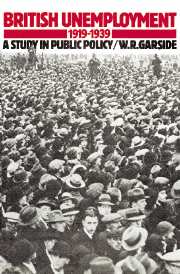Book contents
- Frontmatter
- Contents
- List of tables
- Preface
- Acknowledgements
- PART I INTRODUCTION
- PART II THE LABOUR MARKET UNDER STRAIN
- PART III THE INTERNATIONAL CONTEXT
- 5 On and off gold: unemployment, monetary policy and the exchange rate
- 6 Trade, tariffs and the stimulation of exports
- 7 Men, money and markets: the ‘Empire solution’ to unemployment, 1919–1931
- PART IV STRUCTURAL UNEMPLOYMENT, INDUSTRY AND THE REGIONS
- PART V MACROECONOMIC POLICY OPTIONS: THEORY AND PRACTICE
- Bibliography
- Index
5 - On and off gold: unemployment, monetary policy and the exchange rate
Published online by Cambridge University Press: 21 September 2009
- Frontmatter
- Contents
- List of tables
- Preface
- Acknowledgements
- PART I INTRODUCTION
- PART II THE LABOUR MARKET UNDER STRAIN
- PART III THE INTERNATIONAL CONTEXT
- 5 On and off gold: unemployment, monetary policy and the exchange rate
- 6 Trade, tariffs and the stimulation of exports
- 7 Men, money and markets: the ‘Empire solution’ to unemployment, 1919–1931
- PART IV STRUCTURAL UNEMPLOYMENT, INDUSTRY AND THE REGIONS
- PART V MACROECONOMIC POLICY OPTIONS: THEORY AND PRACTICE
- Bibliography
- Index
Summary
The defence of ‘sound money’ proved a powerful and dominant influence upon the official response to interwar unemployment. Government concern about confidence in the pound and the stability of the budget was of paramount significance in the debacle over unemployment insurance. Questions of cost, likewise, were never far from Ministers' minds whenever alternative schemes to relieve the plight of the unemployed were under consideration, as the previous chapter briefly indicated. The links between domestic and international finance and the unemployment problem were, however, more complex and endemic than have so far been demonstrated. Subsequent chapters will detail the conflict that emerged between fiscal probity and the debate over job creation. We turn first to the effects of monetary policy and the exchange rate upon official attitudes toward unemployment during the 1920s and beyond.
GOLDEN SACRIFICE? UNEMPLOYMENT AND THE STERLING PARITY, 1919–31
To Edwardian observers, the gold standard represented the bedrock of economic stability at home and abroad. It was customarily believed, more as an article of faith than as an established fact, that the free movement of gold occasioned self-adjusting balance of payments equilibria. In classical terms, any differences between foreign receipts and payments would induce changes in a country's stock of gold, forcing a shift in monetary circulation sufficient by its effects on incomes and prices to alter the demand for imports and exports in the requisite direction to correct the balance of trade.
- Type
- Chapter
- Information
- British Unemployment 1919–1939A Study in Public Policy, pp. 115 - 139Publisher: Cambridge University PressPrint publication year: 1990



